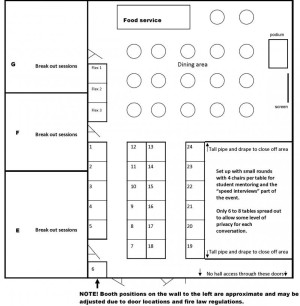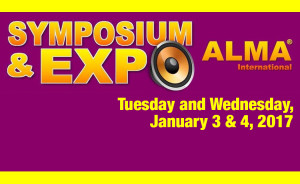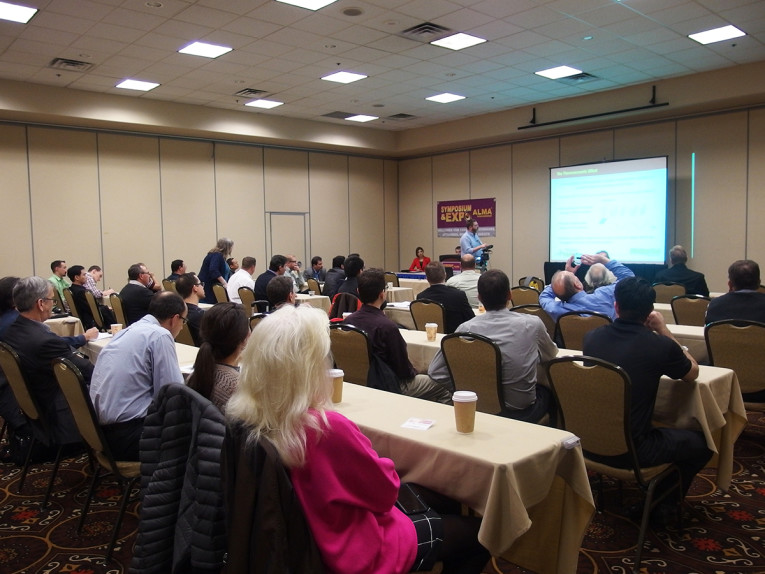

the exhibition area now preceding
access to the conference rooms
and events area.
The 2017 event will also feature new education content for and by students and educators, along with ALMA’s worldclass technical content. Bluetooth SIG will be on hand to update attendees on what is coming next. Highlights of the 2017’s show will include Rosemary Coates’ discussion about bringing manufacturing opportunities to America, a forum on the challenges and opportunities in the car audio industry, a focus on headphone technology, microphones, new wireless protocols, information on doing business in China, brand building in the US and much more!
Also look for an important announcement by ALMA’s Standards Committee led by John Busenitz and Andrew Grunloh.
 AISE attendees who purchase an All Access Pass at the early bird price get our entire event, food, and all breakout sessions for less than some shows charge for just 1 seminar.
AISE attendees who purchase an All Access Pass at the early bird price get our entire event, food, and all breakout sessions for less than some shows charge for just 1 seminar.Educators and Students make crucial connections for Internships, Career opportunities, Research funding, in addition to gaining crucial cutting edge education.
Qualified students get a FREE All Access Pass.
Educators receive deeply discounted attendance.

Here are some of the already confirmed presentations:
Advanced Distortion Analysis Methods
Dan Foley- Audio Precision
For decades THD (Total Harmonic Distortion) and THD+N (Total Harmonic Distortion+Noise) have been the dominant method to characterize distortion of audio electronics and electroacoustic products and systems. These methods have been augmented with intermodulation (two-tone) and multitone distortion but in all cases, the stimulus is based on sinusoidal excitation at a fixed amplitude with an RMS indication of the total distortion (and noise) level. This presentation will focus on the use of nested amplitude sweeps of sinusoidal stimuli in conjunction with and music high-resolution FFT's in order to view the effects of high-order harmonic distortion. With the use of music as a stimulus, detailed analysis of crest-factor changes in the transient and decaying portions of these music signals will be presented.
The Leap From Audio to Communication
Jacob Soendergaard- Head acoustics
Bluetooth powered speakers have gained traction and market share with consumers. They are immensely popular – but have you ever tried using it as a speakerphone? Simply putting a microphone into the speaker case does not result in a complete Bluetooth product. This paper will illuminate some of the many intricacies of testing for Voice and Conversational Quality in a Bluetooth hands-free system. It will show why things like DSP and processing can influence performance, why the basic metric aren’t enough, and ultimately what makes for a good product. Voice and conversational quality performance reflect heavily on perceived product quality and usefulness, which can be greatly improved with some careful thought in the design and testing phase.
In-Vehicle Audio System Distortion Audibility
Steve Temme- Listen, Inc
As in-vehicle audio system output level increases, so too does audio distortion. At what level is distortion audible and how is sound quality perceived as level increases? Binaural recordings of musical excerpts played through the in-vehicle audio system at various volume levels were made in the driver’s position. These were adjusted to equal loudness and played through a low distortion reference headphone. Listeners ranked both distortion audibility and perceived sound quality. The distortion at each volume level was also measured objectively using a commercial audio test system. The correlation between perceived sound quality and objective distortion measurements is discussed.
Developing a Curriculum for a Career in Audio Design Engineering
Dan Foley- Audio Precission
Today's audio design engineer needs to have technical competencies in a wide range of disciplines including but not limited to:
- Acoustics
- Analog and digital electronics
- Audio digital signal processing
- Psychoacoustics
- Wireless technologies such as WiFi and Bluetooth
Dan Foley, having been involved for more than 30 years in proving technical training and support to audio design engineers throughout the world, will present what skills employers are looking for and how one can develop a curriculum suited for the audio industry.
Accurately Measuring Headsets and Handsets
Jacob Soendergaard- Head acoustics
As devices and accessories become more complicated and intelligent, even simple things like impedances can throw off a setting when you’re testing a product. The Headset Interface Box (HIB I) by HEAD acoustics allows you to simulate either a headset - to conduct electrical tests of a handset – or a handset – to accurately measure the acoustic performance of a headset. Headset microphone supply voltages can be dialed in, automatic MIC/GND pin assignment is built in, and microphone paths include variable attenuation/amplification, with the end goal of speeding up and automating measurements of headsets.
An Engineering Analysis of Four Commercial Bookshelf Loudspeakers
Mark Glazer
A follow-up to the ALMA 2016 paper on the development of the Revel Concerta2 line. Four competitively priced 2 way loudspeakers underwent double blind listening tests; CEA 2034 (Spin-o-rama) measurements showed amplitude and directivity differences. This presentation goes beyond, into in-depth analysis of all four loudspeakers at the transducer and system levels. Tests include Linear Parameter Measurements, Large Signal Integration, IM Bass tone and voice tone distortion, CEA 2010, plus others. Results show how the performances were met and the tradeoffs required achieving them.
Reducing Uncertainty In Speaker Testing By Understanding The Complete Measurement Chain
Brian MacMillan & Gregor Schmidle
Small speakers are often the key component in mobile audio systems. Much effort goes into the initial design of the speaker and even more resources to verify that what is manufactured has the specified performance. The risk is that other parts of the measurement chain, like the amplifier or audio measurement channel, can cause a ‘good’ speaker to fail in testing. Also, common tests like measuring a speaker’s impedance mean that the amplifier, and how it is wired as part of the measurement system, is critical in testing. This paper will review the common parameters measured in speaker testing and the requirements these tests place on other, non-speaker, parts of the measurement chain. It will identify those tests where care needs to be taken that other components do not cause a ‘good’ speaker to fail in end of line testing at the OEM of the speaker or incoming inspection at the manufacturer of the mobile audio device. Finally, it will review test setup strategies and provide best practice advice to reduce or mitigate the problem of other components limiting the performance of the test system.
Physical Accuracy and Modeling Robustness of Motional Impedance Models
Claus Futtrup and Jeff Candy
A standard electroacoustic model in terms of mass, resistance and static compliance was well-known by the 1950s. Starting in the 1990s, effort began to improve the simple static compliance with a frequency-dependent form that could describe mechanical creep of the suspension. At present, there are a handful of established creep- compliance models in use: Knudsen LOG, Ritter creep, Thorborg f-dependent damping, and most recently, Novak fractional derivative. These models replace 1-parameter static compliance with a 2 or 3-parameter form. In this work we compare the relative accuracy and modeling robustness of these alternative models when applied to a collection of modern transducers. To compute the fit parameters, we use a novel dual-added-mass approach together with a complex linear least-squares technique

Accurately stressing ANC, Beamforming and Noise Suppression Algorithms
Jacob Soendergaard- Head acoustics
As audio and communication devices become more portable and mobile, the use cases and environments also start to expand. More often than not, significant background noise is now a fact of audio consumption. Naturally, there are several neat techniques beyond passive isolation that help improve audio and voice quality in modern devices: Active Noise Cancellation (ANC), Beamforming and Noise Suppression algorithms all chip in to improve the overall experience. This paper will illustrate some of the systems and metrics used today to acoustically validate the performance of modern mobile audio and communication devices
Identifying Nonlinear Parameters of Large Suspension Parts
Gregor Hoehne
A dynamic identification of loudspeaker suspension parts like spiders, surrounds etc. can be achieved by using measuring techniques as described in the IEC standard 62459. Therefore the device is mounted in a sealed enclosure and excited pneumatically while solely its displacement is measured. However, this technique is limited to suspension parts whose dimensions are much smaller than those of the enclosure. In this paper, a new identification technique is introduced using a microphone as an additional sensor inside the enclosure and a multi-tone as the stimulus. This technique allows the characterization of large parts with considerably small test enclosures, a more robust measurement procedure and the application of a more advanced nonlinear model considering the nonlinearity of the stiffness as well as the damping.
Measuring Maximum Continuous SPL With Multi-Tone Stimuli
Gregor Hoehne
The CEA standard 2010-B describes a procedure to obtain the maximum continuous sound pressure level of a woofer. The standard proposes a weighted pink noise signal as stimulus applied at different levels, giving an estimation of the variation of the linear transfer function due to effects like voice coil heating, fatigue or nonlinear compression. This paper proposes the utilization of a multi-tone signal as stimulus to obtain advanced and easily applicable possibilities for further analysis while maintaining the properties of the signal in the time and frequency domain. It is shown how the properties of the multi-tone can be deployed to estimate the voice coil temperature, the level of non-linear distortion and for advanced methods, revealing the causes of nonlinear symptoms and their contribution to the overall distortion.
Two Approached Of Measuring the Directivity of Distributed Sound Sources Using Spherical Wave Expansion
Christian Deeg
Measuring and describing the directivity of a loudspeaker with the help of spherical wave expansion has a variety of benefits, like the measurement in the nearfield or the ability to compensate room reflections in post-processing. Using this approach for distributed sound sources like line arrays and sound bars requires modifications of the measurement sequence to achieve a sufficient accuracy in the wave field description. The presentation will explain procedures to handle these issues. One is the separate measurement and analysis of each driver by its own and the combination of all the modelled sound pressure in post-processing. This allows the simulation of different delay and gains combinations in the excitation of the loudspeaker. Another approach is the combination of multiple spherical wave expansion to describe one set of measured data. The presentation gives an overview of the different ideas behind both approaches and highlights benefits and drawbacks.
Chasing the Elusive “Good Sound Meter” for Loudspeakers (Multidimensional Audio revisited)
Tim Gladwin
In the 38 years since Moller described a “Good Sound Meter”, are we any closer to realizing it? Circa 1978 Henning Moller and his colleagues at Bruel and Kjaer produced several AES journal articles on “Multidimensional Audio”. He defined “good sound” as existing in both subjective domain and objective domains. In each domain he identified ~40 dimensions that might be considered for holistic audio systems. Moller described a virtual instrument, the “Good Sound Meter”, which (if it existed) could measure the characteristics of an audio system in real time. This meter would mitigate, if not eradicate, many of the faith and myth based loudspeaker philosophies. Some aspects of good sound in loudspeakers have been studied in great depth. The relationship between the frequency and directivity response to subjective listener preference has been determined to a statistically valid degree. Such studies take tremendous resources of time, money and people. For many of the other dimensions that have not been so well scrutinized, superstition and cargo cult science remain. Let’s take a look at the advancements our industry has made in working towards the “Good Sound Meter” and perhaps discuss the next steps.
The Future of Bluetooth Audio
Andrew Becraft
Bluetooth wireless technology has revolutionized the way we listen to music. In the coming years, further developments in the Bluetooth standard will continue to transform what is possible in the world of wireless audio. The current wireless audio experience is built around one to one relationships between audio sources and audio receivers. Starting with improvements made to low energy speed and broadcast capacity available in Bluetooth 5, and developing further with features to come over the next two years, the future wireless audio experience will move beyond personal audio to include public and shared audio sources, streaming over high quality, low energy broadcast, multicast, and unicast channels. Users will be able to transition fluidly between sources and channels in their homes, offices, and public spaces over the course of the day. Future users will control, create, and curate a whole new Bluetooth wireless audioscape.

Seminars
The Power of Brand
Adrian Weidmann
This session will define 'Brand' and explore its power and importance for the commercial success of your product development and/or service- be it a microphone, a loudspeaker or recording studio. Developing, defining and maintaining your brand and its message may the most important 'product' you ever develop. This session will explore the power of Brand and outline seven key components to define your brand. The session will include an innovative and active workshop exercise where you and your colleagues will work together collaboratively in developing your own brand story. The "Brand as Publisher' concept will be introduced, defined and examples will be presented that can be used to create a meaningful dialog between your customers and your brand across available customer touchpoints- human, mobile, social media, web and print. Understanding the power of this customer dialog can provide innovative insights for you, your product development and entire team as well as propel your Brand forward.
It’s Time to Bring Manufacturing Back to America
Rosemary Coates
According to a recent study, 54% of US manufacturers over $1billion in revenue are considering Reshoring some or all of their manufacturing. Manufacturing is essential to rebuilding our middle class and our economy. It’s important for our future and our children’s future. It’s bi-partisan and is on every politician’s agenda to support jobs growth. But it’s not as easy and you may think, and requires strategy, planning and a commitment to invest in rebalancing your global supply chain. Companies need to determine what to manufacture in America and what to leave in low-cost manufacturing countries.
Maximizing the Utility of the Acoustic Fourier Transform: From Recommended Best Practices to Nearfield Acoustic Holography
Dr. Andrew R Barnard
Fourier transform analysis is a commonly used technique in acoustics and vibration. It is so ubiquitous with acoustic analysis, that it has almost become an afterthought: a magic black box in the software that transports our measured time histories to the frequency domain. This seminar will discuss best practices to processing accurate Fourier transforms in many domains. Topics will include Frequency Response Functions (FRFs) and Coherence functions, coherent signal processing, Cepstral analysis, spatial Fourier transforms, wavenumber domain analysis, Nearfield Acoustic Holography (NAH), and sound field separation. NAH theory will be presented with focus on how to properly set up an NAH measurement. Application examples will focus on acoustic measurements using microphones and accelerometers.
Destroying Amplifier and Signal Processing Advancements For Loudspeaker Control
Gregor Hoehne
Progressing miniaturization and portability introduce new challenges for loudspeaker design. Demands like higher efficiency and reduced weight might be achieved by solving requirements like protection against overload or linearity with digital signal processing instead of in the mechanical design. The developments in integrated circuits design provide cost-effective and space-saving solutions for amplifiers with an included pre-processing of the signal. Modern audio amplifiers tend to provide full digital interfaces making features like accurate dc-coupling or voltage and current sensing easily feasible for signal processing. This seminar gives an introduction into adaptive loudspeaker control and how it can be used to equalize, stabilize, linearize and actively protect transducers. It covers an introduction into the topic and the underlying theory as well as various aspects of integrating such a system into a loudspeaker design and evaluating its performance. An emphasis lies on how dc-coupled amplifiers can be utilized to enhance loudspeaker performance.
New Standard For Electrical and Mechanical Transducer Measurements
Christian Deeg
This seminar reports on the progress made in the development of a new IEC standard dedicated to electrical and mechanical measurements (part B) complementing the acoustical measurements (part A) presented at previous AES conventions. Both standards are applicable to all kinds of transducers, active and passive loudspeakers and other sound reproduction systems. Not only provide voltage and current measured at the electrical terminals the electrical input impedance but also meaningful parameters of linear, nonlinear and thermal models describing the behaviour of the transducer in the small and large signal domain. This standard addresses long-term testing to assess power handling, heating process, product reliability and climate impact. New mechanical characteristics are derived from laser scanning techniques which are the basis for modal analysis of cone vibration and predicting the acoustical output. The electrical and mechanical data are required for transducer and system design based on numerical simulations (FEA, BEA) and digital signal processing protecting the transducer and correcting the transfer behavior actively.
More Content to be Confirmed
January, 3-4 (Tuesday - Wednesday)
ALMA International Symposium & Expo 2017
www.almainternational.org






